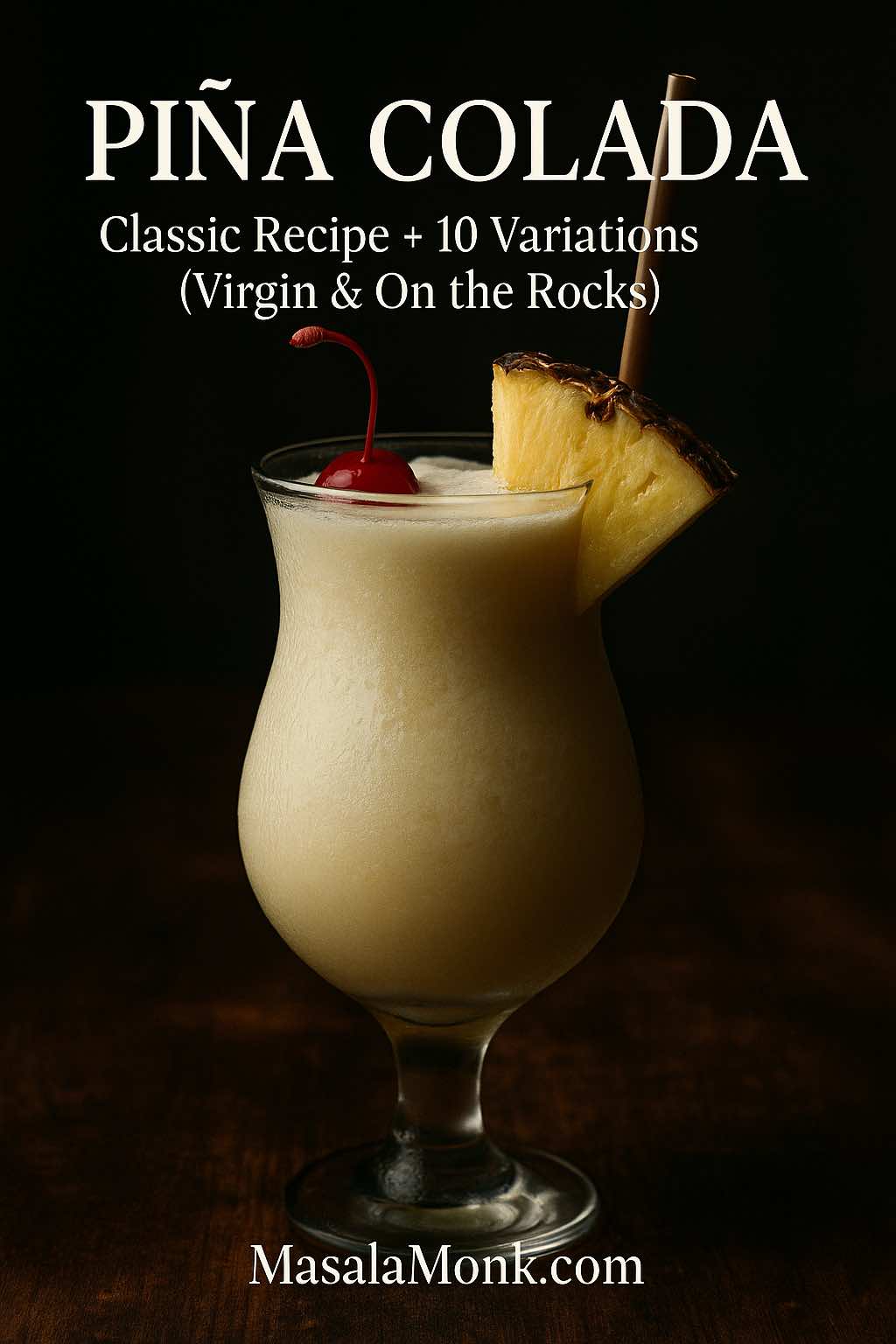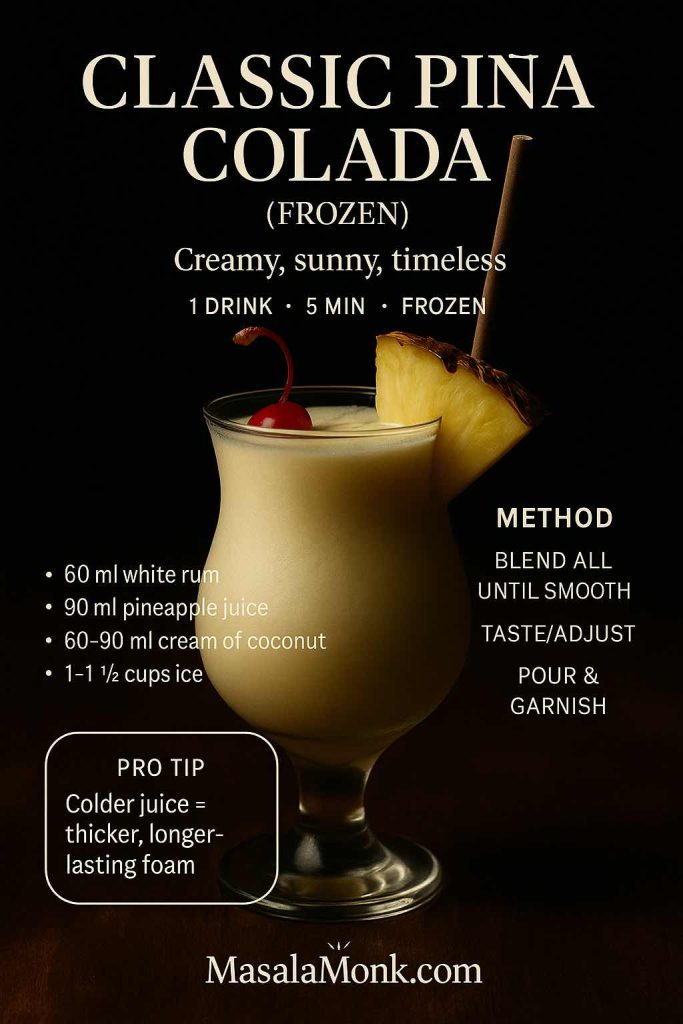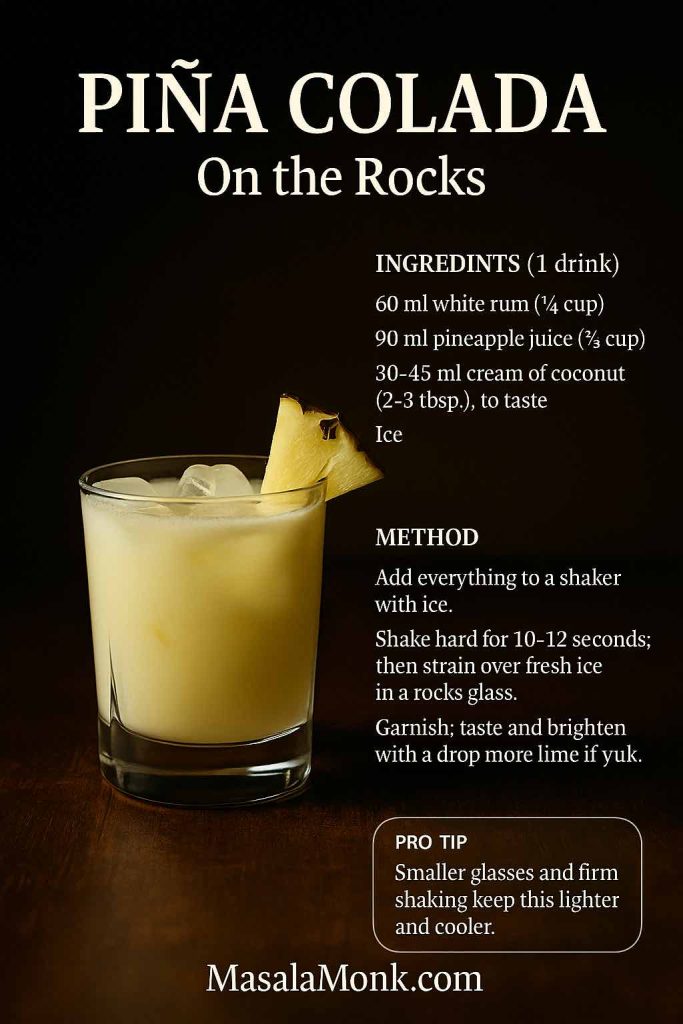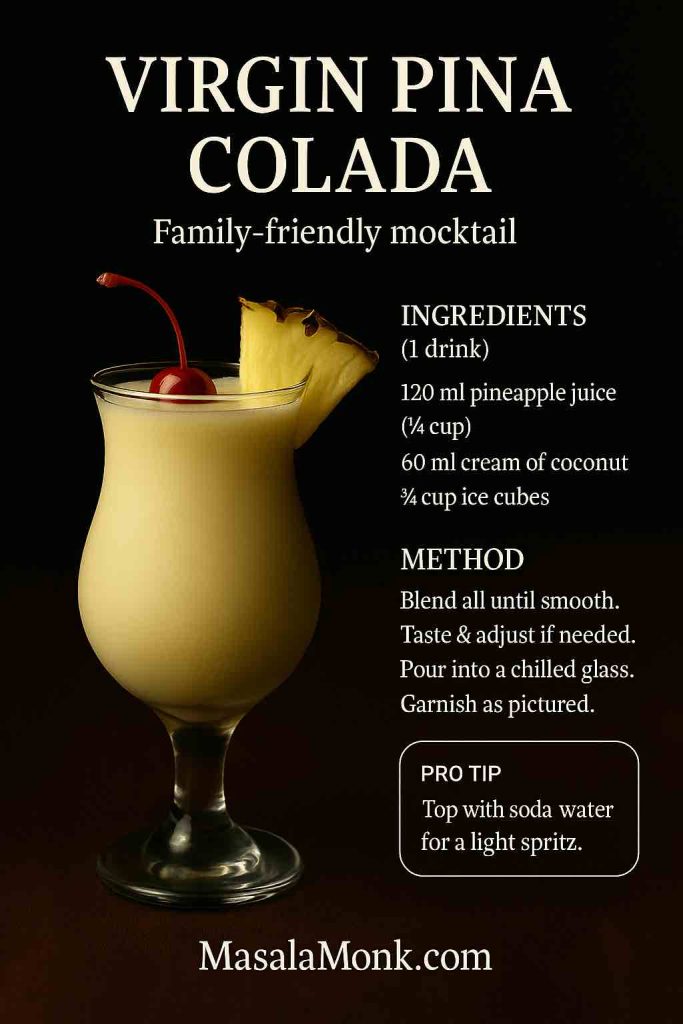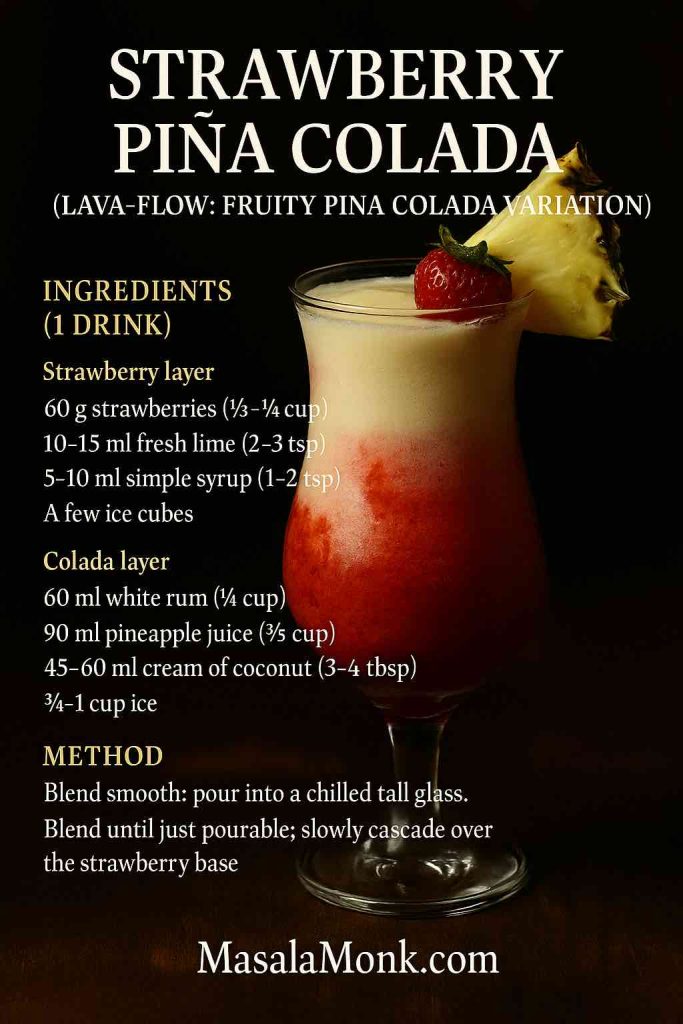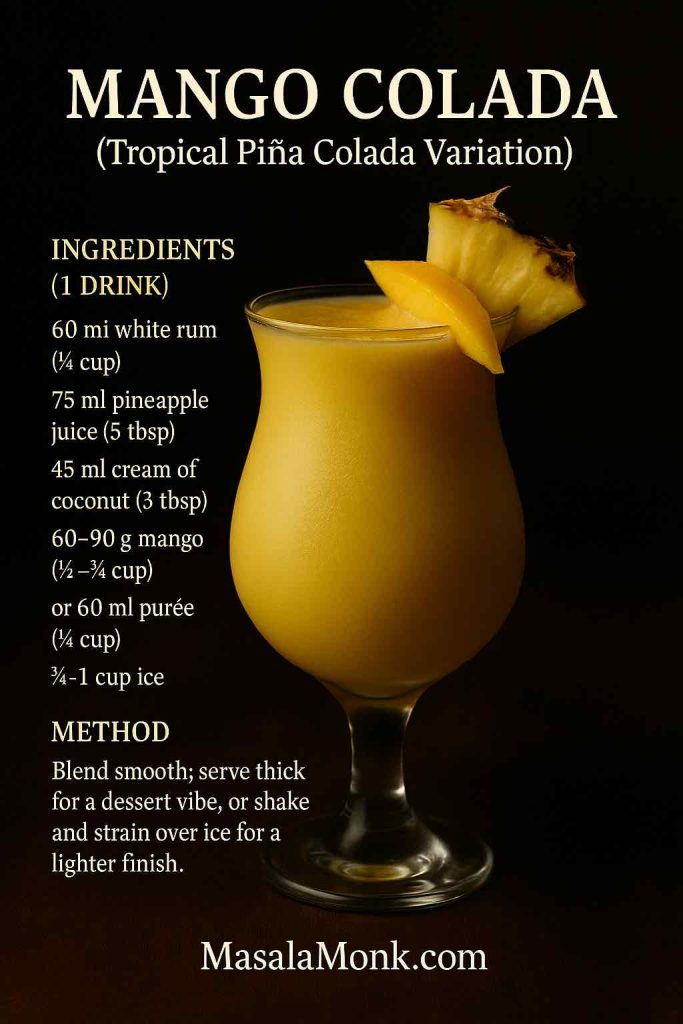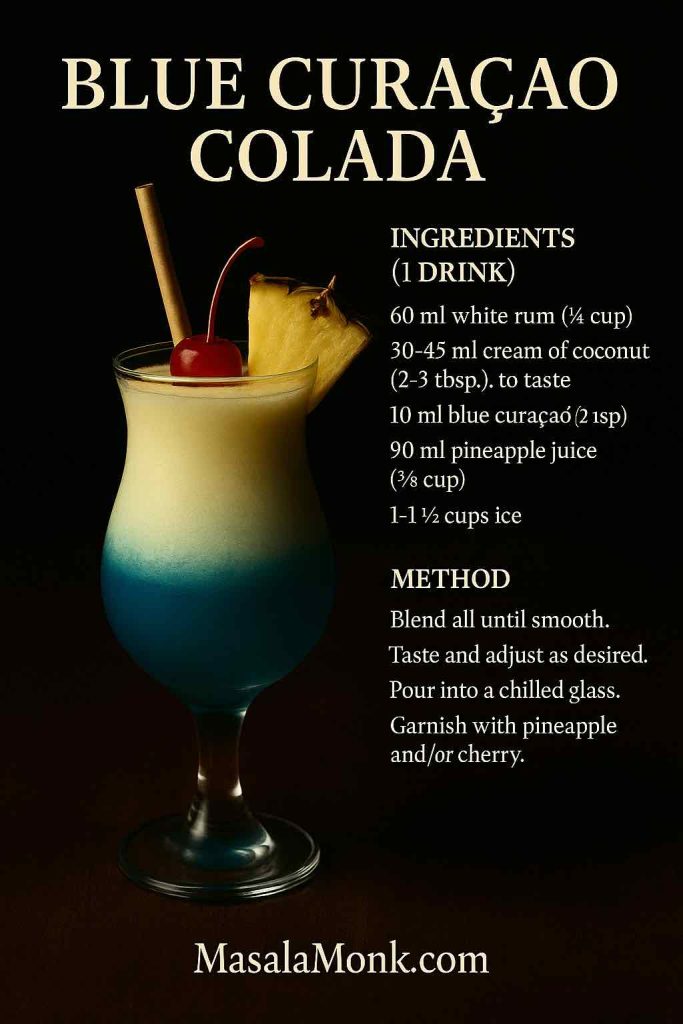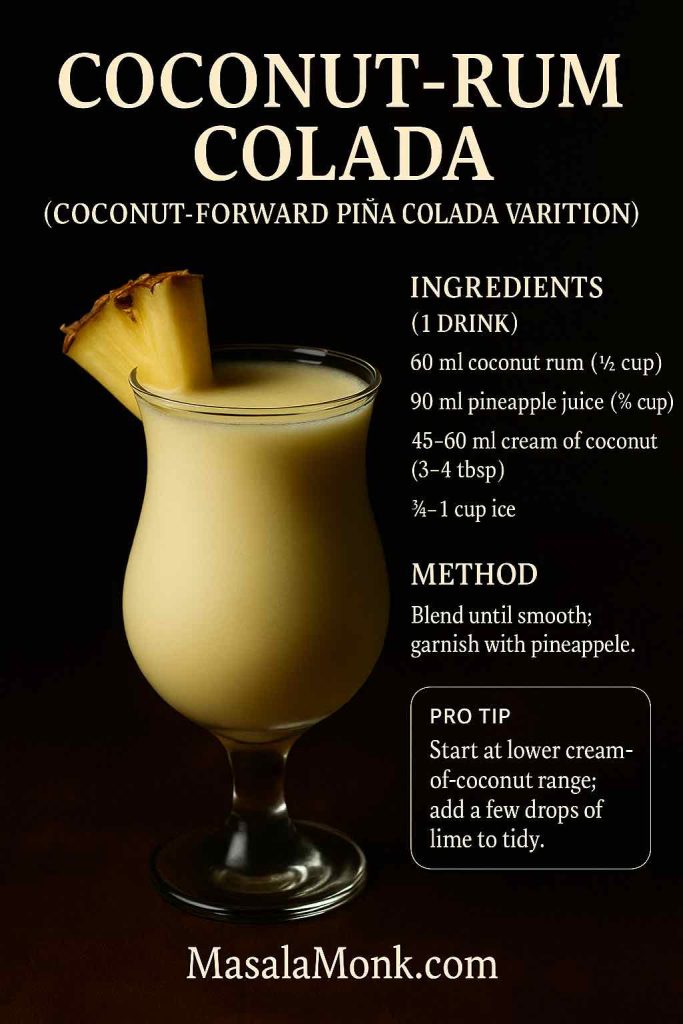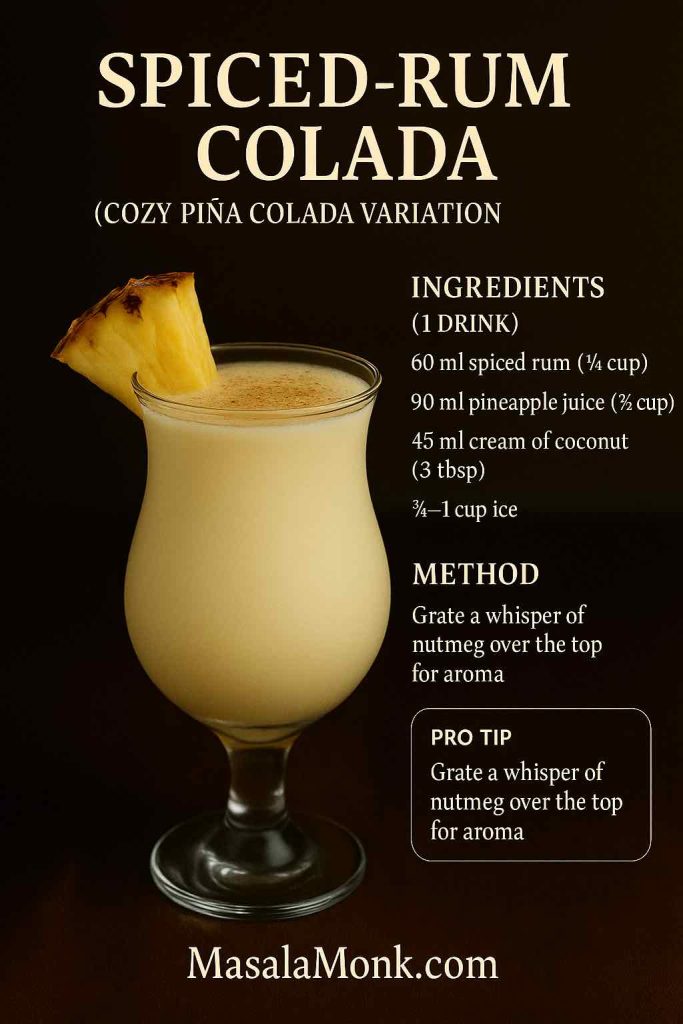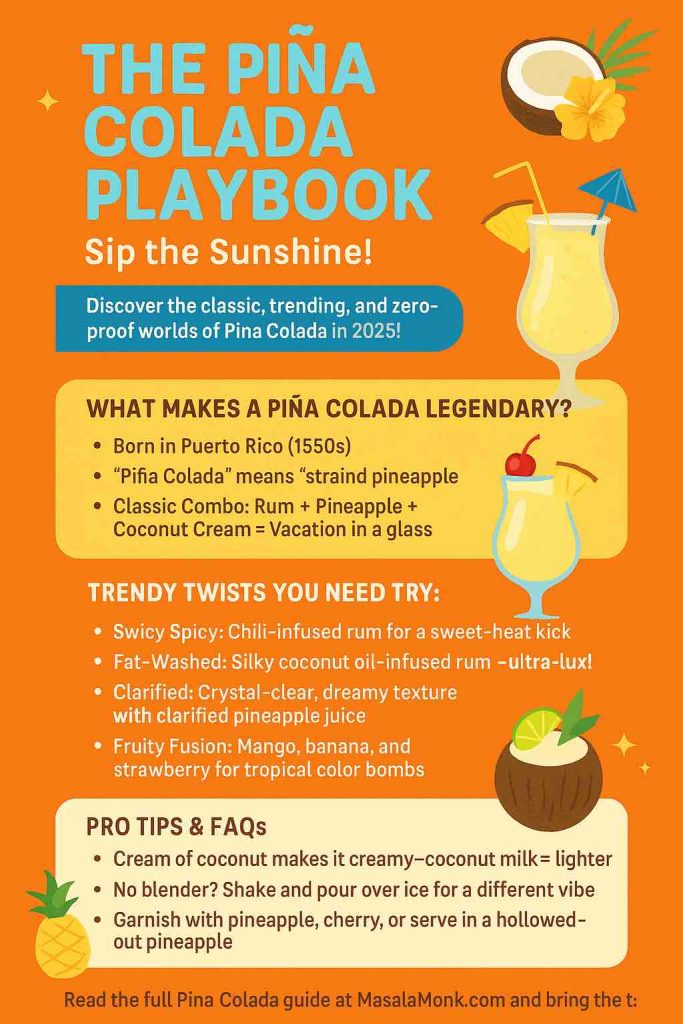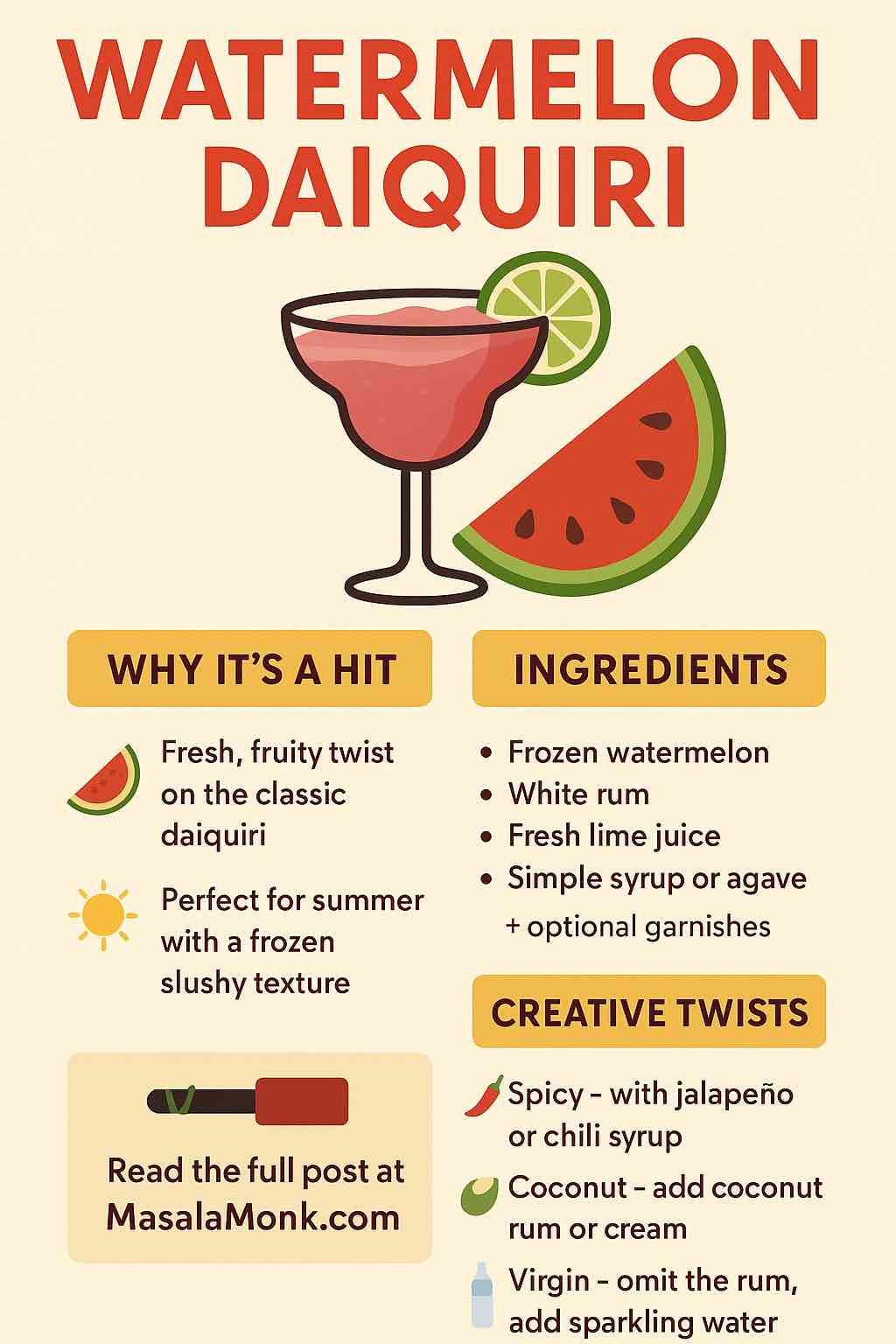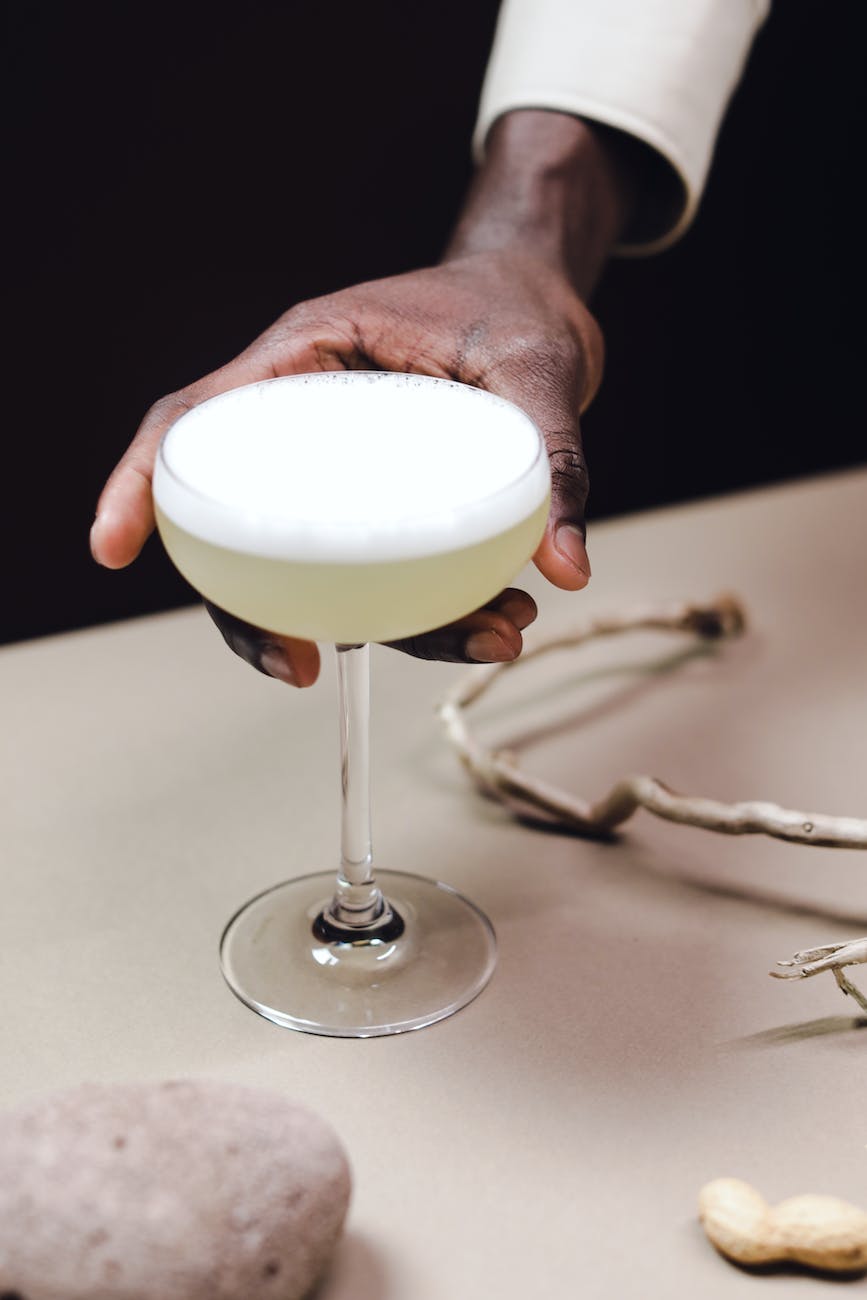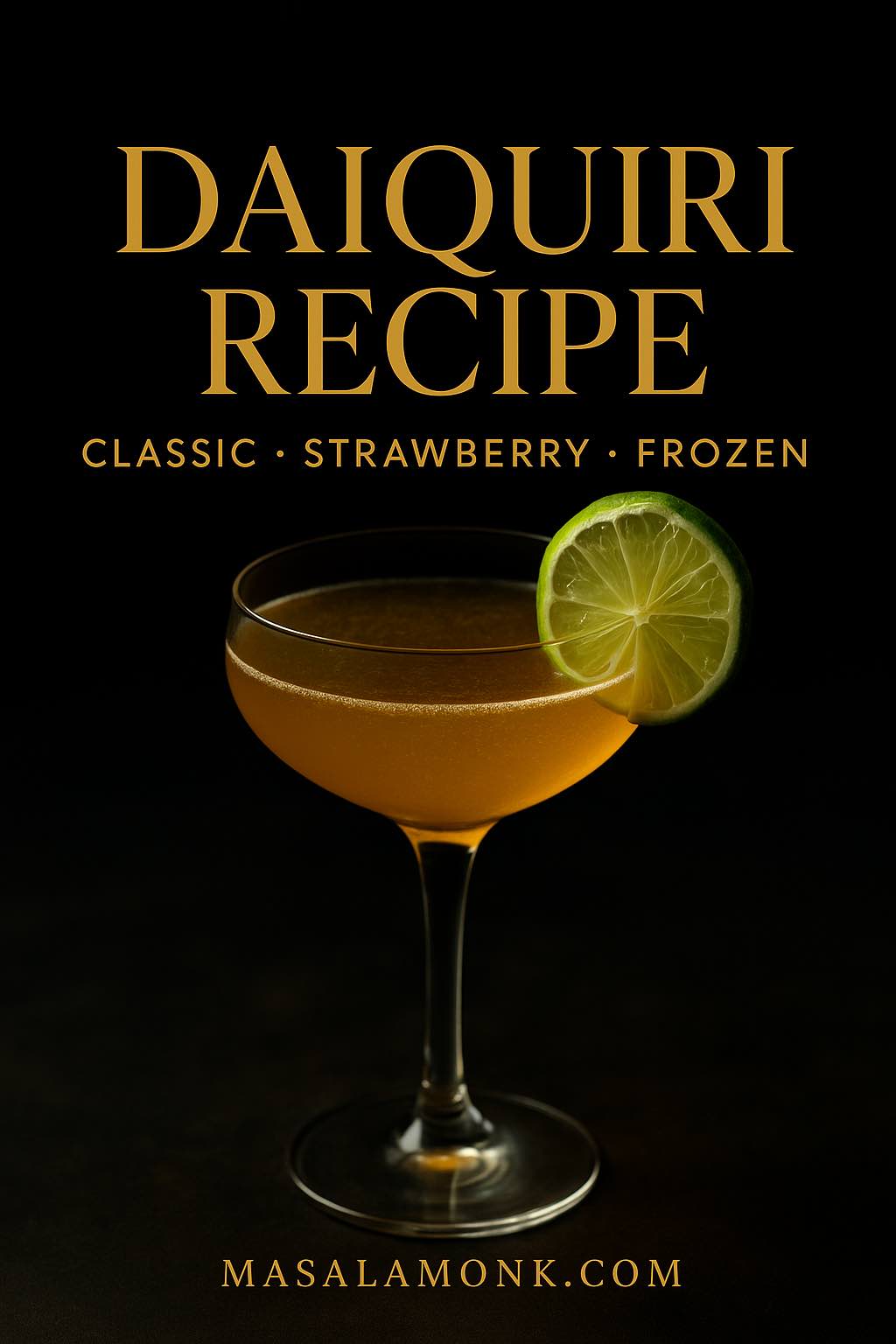
Sometimes a cocktail feels like a small holiday. The Daiquiri is exactly that—bright, chilled, and direct. It began in Cuba as a simple mix of rum, lime, and sugar; yet, over time, it grew into a family of drinks that includes fruity crowd-pleasers and dry, elegant riffs. In this guide, you’ll first master the classic Daiquiri Recipe that bartenders rely on. Then, you’ll ease into a Strawberry Daiquiri Recipe—first on the rocks, then frozen for that beach-bar feel. After that, you’ll explore banana, mango, pineapple, and the grapefruit-and-maraschino-kissed Hemingway version. Throughout, you’ll learn how to balance sweetness and acidity, how to tune texture, and how to fix the most common mistakes—so your next round tastes exactly the way you imagined.
Because precision leads to confidence, we’ll work in milliliters and clear steps. Because context helps, you can also check the International Bartenders Association’s Daiquiri for a classic benchmark: International Bartenders Association’s Daiquiri. And because technique matters, this practical deep dive from Serious Eats is a smart companion: Serious Eats: Daiquiri.
Before You Mix: Ingredients, Tools, and Ratios
First, choose a clean, unflavored white rum at 40–45% ABV; column-still Caribbean styles are ideal because they’re crisp and let lime shine. Next, insist on fresh lime juice; bottled juice dulls the aroma and throws off acidity. Then, make simple syrup (1:1 sugar to water by volume) or a rich syrup (2:1) if you prefer extra body—Difford’s explains that richer syrup changes mouthfeel and dilution: Difford’s Guide: Daiquiri.
For tools, you’ll want a shaker, strainer (and ideally a fine strainer), jigger, and a chilled coupe or rocks glass. As for ratios, start with 4:2:1 (rum:lime:syrup) when you like it drier, 4:2:1.5 when you want a balanced home style, and 4:2:2 when you’re blending frozen where cold mutes sweetness.
Daiquiri Recipe (Classic, 2 Servings)
What you’ll taste: Clean rum character, bright lime, and a gentle, polished sweetness. Because there’s nowhere to hide, balance is everything.
Ingredients
- 120 ml white rum (40–45% ABV)
- 60 ml fresh lime juice (about 2 limes)
- 30–45 ml simple syrup (1:1), to taste
- Plenty of ice
- Lime wheel, to garnish
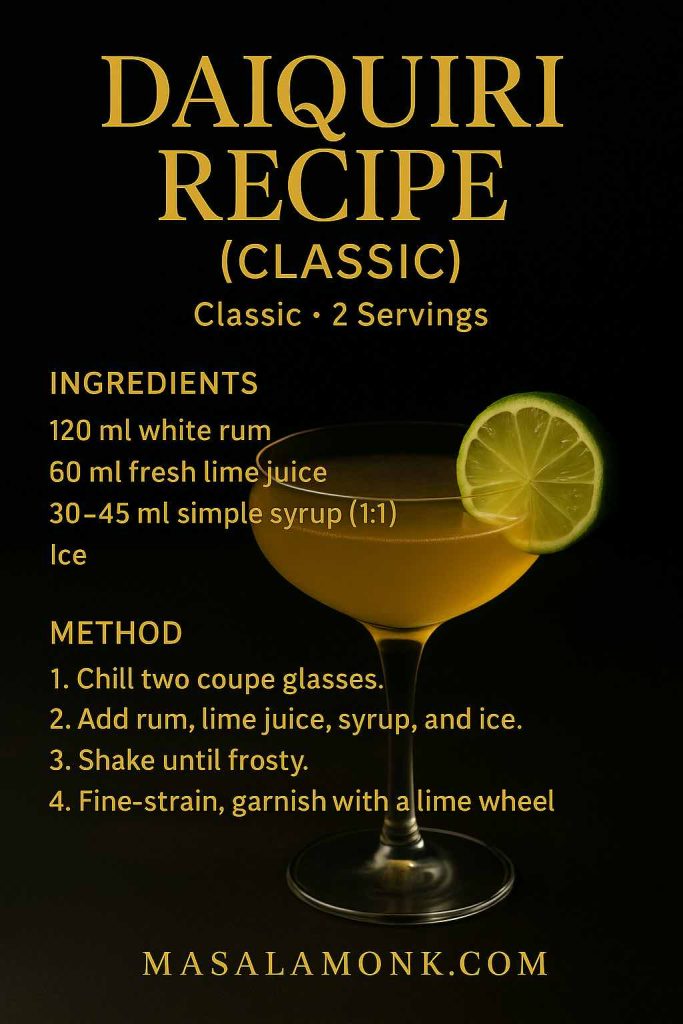
Method, step by step
- First, chill two coupe glasses. Cold glassware keeps texture tight.
- Next, add rum, lime, and 30 ml syrup to a shaker; then fill with ice.
- Now shake hard for 12–15 seconds until the tin frosts; vigorous shaking aerates and integrates.
- After that, fine-strain into the chilled coupes; fine-straining removes shards and makes the surface glossy.
- Finally, garnish with a lime wheel. Taste; if you prefer softer acidity, increase the syrup to 45 ml next round.
Why it works (briefly): Rum brings warmth; lime delivers snap; syrup knits them together. If you want an alternative spec with a light caramel edge, try demerara syrup as shown here: Liquor.com: Classic Daiquiri.
Common fixes: If it’s too sour, add 7.5–15 ml syrup and shake again for 5 seconds. If it’s too sweet, add 7.5–15 ml lime and shake briefly. If it feels thin, use rich (2:1) syrup next time and ensure the glass is properly chilled.
Do read: What to Mix with Jim Beam: Best Mixers & Easy Cocktails.
Strawberry Daiquiri Recipe (On the Rocks)
What you’ll taste: Fresh strawberry aroma first, then lime brightness, then a clean rum finish. Because strawberries vary, you’ll tune sweetness gently.
Ingredients
- 120 ml white rum
- 60 ml fresh lime juice
- 30–45 ml simple syrup (1:1)
- 6–8 ripe strawberries, hulled
- Ice
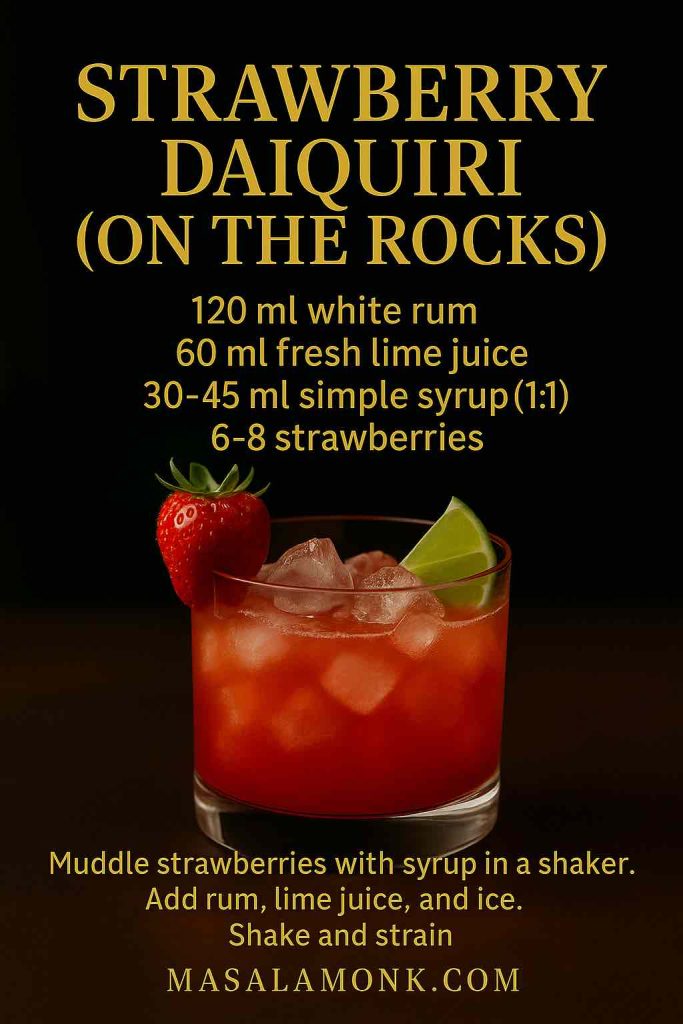
Method, step by step
- First, in a shaker, muddle strawberries with the syrup until they’re juicy and fragrant.
- Next, add rum and lime; then pack the shaker with ice.
- Now shake briskly for 10–12 seconds.
- After that, fine-strain over fresh ice in a rocks glass; this keeps seeds and pulp out while preserving color.
- Finally, garnish with a strawberry and lime wedge.
Flavor notes & smart swaps:
- If your berries are under-ripe, increase syrup slightly; if they’re super sweet, bump the lime.
- For a Strawberry Daiquiri with vodka, swap rum 1:1 for a cleaner, more neutral base.
- For a Spiced Rum Strawberry Daiquiri, keep syrup modest; spices add perceived sweetness.
If you’d rather blend than shake, this is a reliable baseline for blender structure: Liquor.com: Strawberry Daiquiri.
Frozen Strawberry Daiquiri (Thick, Slushy, Crowd-Pleaser)
What you’ll taste: Cold, lush strawberry with lively lime; thicker body; a touch more sweetness to counter the deep chill.
Ingredients
- 120 ml white rum (or coconut rum for a Malibu-style vibe)
- 60 ml fresh lime juice
- 45–60 ml simple syrup (frozen fruit is less sweet)
- 2 cups frozen strawberries
- 1–1½ cups ice, as needed
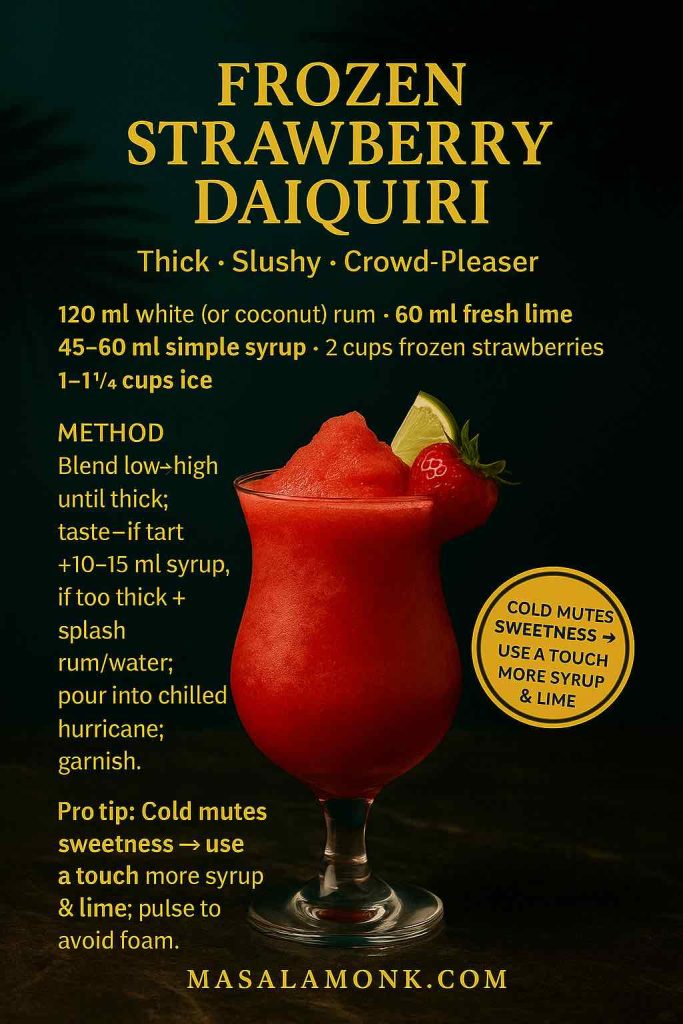
Method, step by step
- First, add everything to a blender.
- Next, start on low to break up the ice; then increase speed until thick but pourable.
- Now taste. If it’s too tart, add 10–15 ml syrup; if it’s too thick, add a splash of rum or cold water.
- Finally, pour into a chilled hurricane or stemmed glass and garnish.
Why frozen needs tweaking: Because cold suppresses sweetness and aroma, frozen builds need slightly more syrup and more lime. For an excellent explanation of this balancing act, see: Serious Eats: The Best Frozen Strawberry Daiquiri. Alternatively, this stylish approach keeps dilution in check by leaning on frozen berries over ice: Bon Appétit: Strawberry Daiquiri.
Brand-friendly variants:
- Malibu Strawberry Daiquiri: coconut rum adds dessert-tropical notes; therefore, keep lime bright.
- Bacardi Strawberry Daiquiri: a clean white rum keeps fruit forward; avoid oversweetening.
- Best strawberry daiquiri mix (when using premix): taste first; then add lime and, if necessary, a splash of water to restore balance.
Banana Daiquiri Recipe (Creamy & Fragrant)
What you’ll taste: Ripe banana creaminess with lime lift; silky, almost dessert-like, yet still refreshing.
Ingredients
- 120 ml white or lightly aged rum
- 60 ml fresh lime juice
- 30–45 ml simple syrup
- 1 very ripe banana (120–140 g), sliced
- Optional: 15 ml banana liqueur for extra depth
- About 1 cup ice
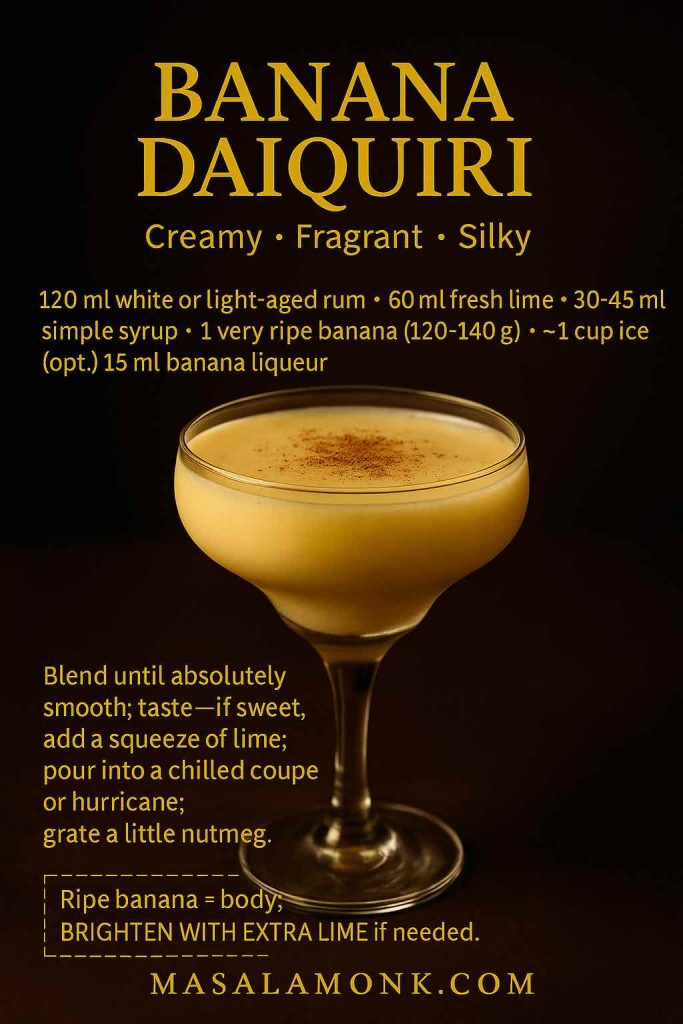
Method
Blend until absolutely smooth; then pour into a chilled coupe or hurricane glass. A light grate of nutmeg adds warmth without heaviness. If it leans sweet, add an extra squeeze of lime and blend briefly.
Mango Daiquiri (Sunny & Lush Recipe)
What you’ll taste: Dense mango richness, lifted by lime; a tiny pinch of salt makes the fruit pop.
Ingredients
- 120 ml white rum
- 75–90 g mango flesh (fresh or frozen)
- 60 ml fresh lime juice
- 30–45 ml simple syrup
- About 1 cup ice
- Pinch of salt (optional but recommended)
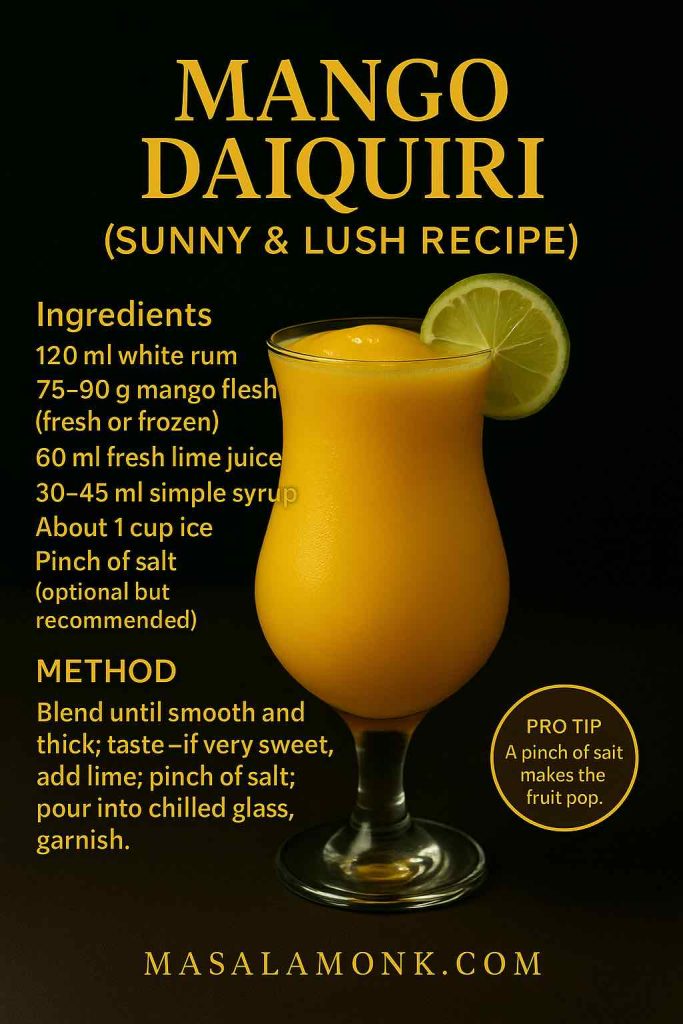
Method
Blend to a thick, spoon-coating texture. Taste; if mango is very sweet, increase lime 5–10 ml. Because mango is dense, a pinch of salt sharpens definition.
Also Explore: Mango Vodka Cocktail: The Perfect Base + 7 Must-Try Variations.
Recipe for Pineapple Daiquiri (Tart-Sweet Snap)
What you’ll taste: Pineapple foam and perfume, anchored by lime; zippy and easy-drinking.
Ingredients
- 120 ml white rum
- 120 ml pineapple juice (or 120–150 g fresh pineapple)
- 30 ml fresh lime juice
- 15–30 ml simple syrup, to taste
- Ice
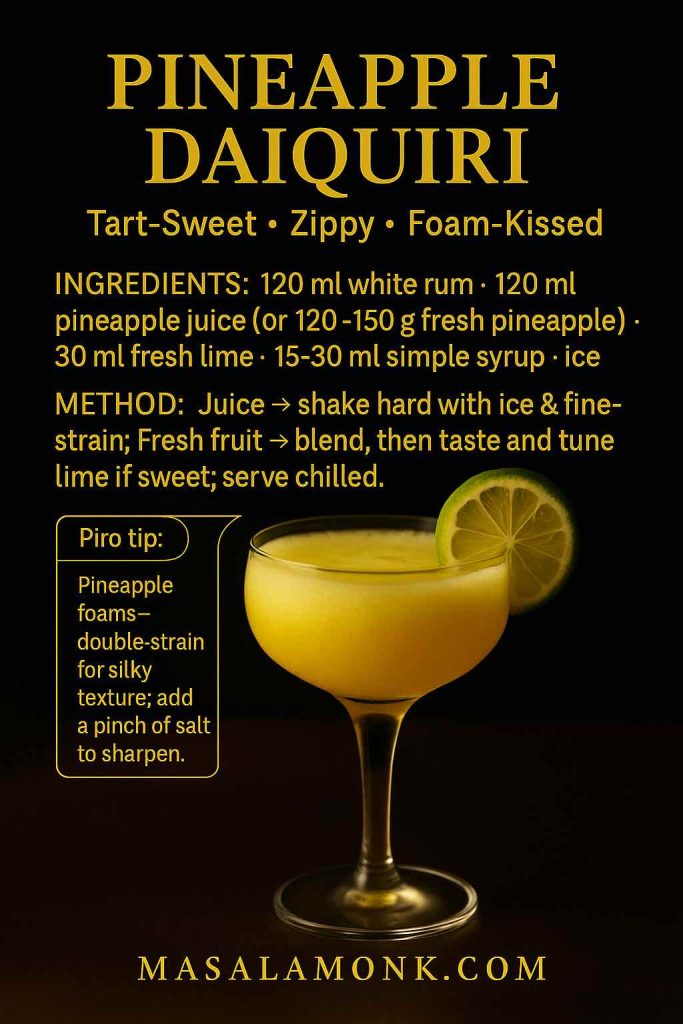
Method
If using juice, shake hard with ice and fine-strain into a chilled glass. If using fresh pineapple, blend; then taste and tune with lime because fresh fruit can be sweeter.
Virgin note: For a virgin daiquiri, replace rum with cold water or a non-alcoholic spirit; keep lime bright and sweetness modest.
Do Read: Punch with Pineapple Juice: Guide & 9 Party-Perfect Recipes.
Hemingway Daiquiri Recipe (Grapefruit, Lime & Maraschino)
What you’ll taste: Lean, dry refreshment with grapefruit bitterness, lime zip, and a perfumed cherry-almond whisper from maraschino.
Ingredients
- 120 ml white rum
- 45 ml fresh grapefruit juice
- 30 ml fresh lime juice
- 7.5–15 ml maraschino liqueur
- Optional: 7.5–15 ml simple syrup (traditionally on the drier side)
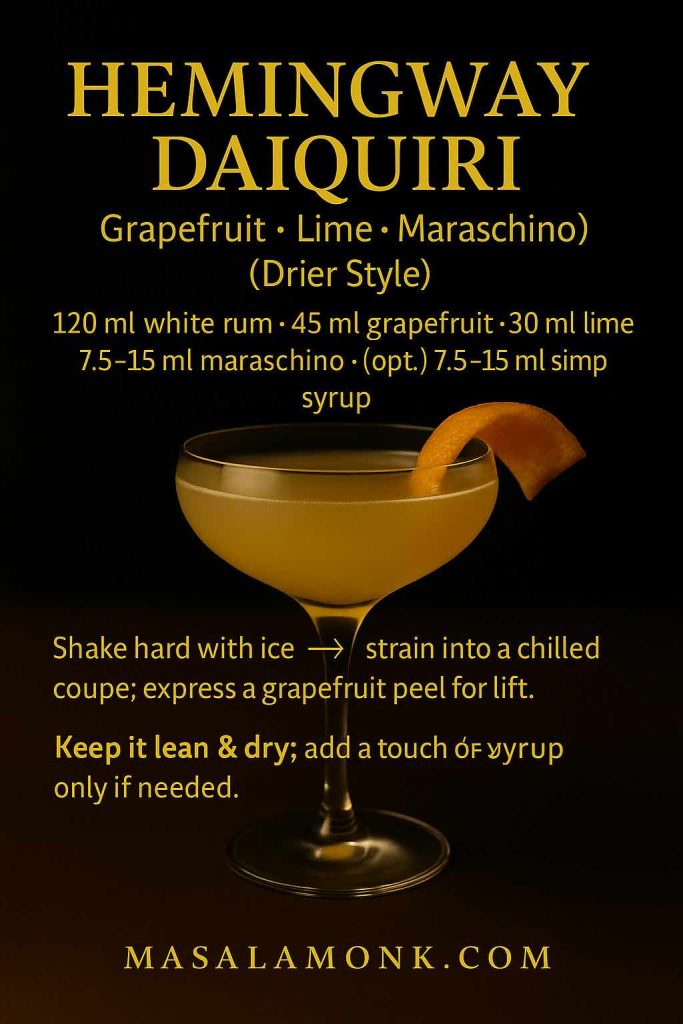
Method
Shake with ice; then strain into a chilled coupe. Express a grapefruit peel if you want extra lift.
For a formal reference, browse the IBA’s Hemingway Special (listed under a variant name): IBA: Hemingway Special. For a bar-tested version with great balance, try: PUNCH: St. John Frizell’s Hemingway Daiquiri.
Ingredient & Technique Notes for Daiquiri Recipe
Best white rum for daiquiri: Choose a clean, unflavored white rum around 40–45% ABV. Because heavy oak can mask citrus, avoid deeply aged styles in these recipes. For strawberry, neutrality helps fruit shine; consequently, straightforward white rum is perfect.
Simple syrup strength: Use 1:1 for shaken, lighter-bodied classics; switch to 2:1 in frozen builds when you want extra texture and less melt. For why syrup strength changes mouthfeel and dilution, see: Difford’s Guide: Daiquiri.
Fresh vs premade mix: Convenience matters, especially for parties. However, many mixes are very sweet. Therefore, always taste first; then add fresh lime and, if necessary, a splash of water. This one minute of tuning usually converts “meh” into “oh wow.”
Blenders & dilution: Start low, then increase speed; short pulses prevent foam. Because colder drinks read less sweet, frozen recipes typically need slightly more syrup and slightly more lime than their shaken counterparts.
Make-Ahead, Batching, and Slush Machines
Batch the classic (with alcohol): Combine rum, lime, and syrup in a bottle and chill for up to 2–3 days. When serving, shake individual portions with ice; shaking restores texture you lose in the fridge. If someone asks about “to-go,” this is the best at-home equivalent: cold, quick, and consistent.
Freezer fruit pouches: Pre-portion fruit purées with syrup in freezer bags. Later, blend a pouch with rum and lime for instant frozen daiquiri drinks. Because the fruit is already cold, texture turns out thicker and more stable.
Slush machine basics: Aim for 10–12% ABV and start near 4:2:2 (rum:lime:syrup). After the machine stabilizes, taste the result. If it’s watery, increase syrup slightly or reduce total water. If it’s too sweet, add measured lime and let the machine pull it back to equilibrium.
When Something’s Off: Quick, Real Fixes
- Too sour → add 7.5–15 ml syrup, then shake or blend briefly.
- Too sweet → add 7.5–15 ml lime; a tiny pinch of salt can also sharpen fruit.
- Too thin → use less ice, chill glassware, or switch to rich (2:1) syrup.
- Not enough strawberry → reduce ice, add more berries, or blend a small spoon of strawberry daiquiri mix as a booster and retune lime.
More Refreshing Drinks You Might Love
If strawberry hit the spot, try this sunny twist next: Watermelon Daiquiri. If coconut sounds perfect, head to this practical guide: Piña Colada (classic & virgin). And if you’re exploring lower-sugar or zero-alcohol options, these ideas keep flavor first: Keto/Low-Carb Mocktails.
FAQs
1. What is the classic Daiquiri Recipe ratio?
Start with 4:2:1 (rum:lime:simple syrup). Then, if you prefer a slightly rounder profile, move to 4:2:1.5. Finally, for frozen builds where cold mutes sweetness, 4:2:2 often tastes best.
2. Which white rum for Daiquiri gives the cleanest result?
Choose a clean, unflavored white rum (40–45% ABV). Consequently, column-still Caribbean styles shine in a classic Daiquiri and in a Strawberry Daiquiri Recipe, because they let lime and fruit lead.
3. Can I make a vodka Daiquiri or Strawberry Daiquiri with vodka?
Yes—swap rum 1:1 with vodka. However, the drink will taste cleaner and a bit less characterful, so consider a touch more lime to keep it vivid.
4. How do I balance a frozen strawberry daiquiri that tastes dull?
Because cold suppresses sweetness and aroma, add 10–15 ml syrup and a small squeeze of lime, then blend briefly. As a result, fruit pops and texture stays thick.
5. What’s the difference between a classic daiquiri and a rum daiquiri?
They’re the same family: rum, lime, and sugar. Nevertheless, “rum daiquiri” sometimes appears when people contrast it with fruit versions like banana daiquiri or mango daiquiri.
6. Which sweetener works best—simple syrup or rich syrup (2:1)?
For shaken classics, use 1:1 for clarity. Conversely, in frozen builds, 2:1 adds body and resists over-dilution, improving frozen daiquiri texture.
7. How do I make a Virgin Strawberry Daiquiri that still tastes exciting?
Blend frozen strawberries, fresh lime, and simple syrup with cold water or a zero-proof “rum”. Then, if it feels flat, add a pinch of salt and an extra squeeze of lime to lift it.
8. What’s inside a Hemingway Daiquiri (a.k.a. Hemingway cocktail)?
It mixes white rum, grapefruit juice, lime juice, and maraschino liqueur. Therefore, it’s drier and crisper than a sweet fruit daiquiri—perfect when you want refreshment without heaviness.
9. Can I use Malibu or other coconut rums for a Malibu Strawberry Daiquiri?
Absolutely. Because coconut rum reads sweeter, keep lime bright and, if needed, reduce syrup slightly. Consequently, you’ll get a dessert-tropical profile without cloying sweetness.
10. Is a Bacardi Strawberry Daiquiri different from other versions?
Functionally, no. Nevertheless, Bacardi Carta Blanca is a clean base many home bartenders know, which helps keep the strawberry daiquiri fruit-forward and balanced.
11. Should I buy a daiquiri mix or make it fresh?
Fresh tastes brighter. However, if you use daiquiri mix (even a daiquiri mix with alcohol), taste first; then rebalance with lime and, when needed, a splash of water. As a result, the sweetness levels out quickly.
12. How do I batch a Daiquiri Recipe for parties or “to-go”?
Combine rum, lime, and syrup in a bottle and chill 2–3 days max. Then, shake each serve with ice before pouring. Consequently, you restore the airy texture you can’t get from the fridge alone.
13. What are the best fruits for quick riffs—banana, mango, pineapple, peach?
All four work beautifully. Because banana adds body, keep lime bright. Meanwhile, mango benefits from a pinch of salt. Pineapple is sweet and foamy, so use modest syrup. Finally, peach varies; adjust lime and syrup in small steps.
14. Can I run a frozen daiquiri in a slush machine?
Yes. Start around 10–12% ABV and 4:2:2 (rum:lime:syrup). After it stabilizes, taste and, if watery, increase syrup slightly or reduce water. Consequently, the machine pours thicker and smoother.
15. What glass should I use for a classic daiquiri cocktail vs a daiquiri drink on the rocks?
Serve the classic up in a chilled coupe for a sleek, silky sip. Alternatively, serve fruit-heavy or strawberry daiquiri drink builds over ice in a rocks or hurricane glass.
16. How do I fix a strawberry daiquiri drink recipe that’s too icy or foamy?
First, reduce total ice and blend in short pulses. Next, increase fruit slightly or switch to rich syrup for more body. Finally, fine-strain if needed for a smoother finish.
17. Which white rum for strawberry daiquiri gives the brightest fruit?
Pick a neutral, unflavored white rum; consequently, strawberries and lime remain the stars. If using spiced rum strawberry daiquiri, keep syrup low, because spices add perceived sweetness.
18. What’s the simplest 4-ingredient Strawberry Daiquiri at home?
Use white rum, lime juice, simple syrup, and strawberries. Then, if you prefer frozen, substitute frozen strawberries and add a little more syrup and lime for balance.
19. Can I make a non-frozen Strawberry Daiquiri that still feels special?
Yes—muddle fresh strawberries with syrup, shake with rum and lime, and fine-strain into a chilled rocks glass over fresh ice. Therefore, you’ll keep vivid color and aroma without a blender.
20. Any quick rule for tuning sweetness and acidity across all Daiquiri Recipe variations?
Absolutely: adjust in 5–15 ml steps, taste, and adjust again. Because micro-changes stack up, this gentle approach keeps every daiquiri—classic, strawberry, frozen, or virgin—balanced and repeatable.

